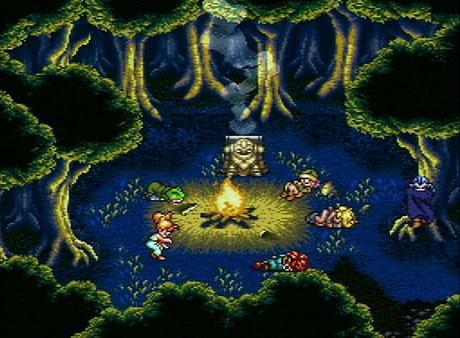Last month, we asked people to submit questions for Chris Melissinos, curator of The Art of Video Games exhibition at the Smithsonian American Art Museum. We received more than 85 great and thoughtful questions, so thank you to everyone that participated! While we would love for Chris to answer all of the questions, he is busy working on the exhibition, so here are his answers to five of our favorites.

Chrono Trigger, 1995, Akira Toriyama, Character Design. ©1995 SQUARE ENIX CO., LTD. All Rights Reserved. Illustration: ©1995 BIRD STUDIO / SHUEISHA. Story and Screenplay: ©1995 ARMOR PROJECT / SQUARE ENIX.
Eye Level: What do you think video games as an artistic medium uniquely have to offer? (Submitted by Chris McClintock)
Chris Melissinos: All video games include classic components of art—striking visuals, a powerful narrative, a strong point of view. What's new is the role of the player. Video games are a unique form of artistic expression through, what I call, the "three voices:" the voice of the designer or artist, the voice of the game and its mechanics, and the voice of the player. A designer can craft an experience that follows a pre-determined arc to a set conclusion, while allowing the player the ability to laterally move and experience the game world. This retains the authoritative voice of the creator, yet allows each player to have a unique experience. There is no other form of media that allows for these three distinct voices to combine and present themselves as the output of expression. It's fantastic that the Smithsonian American Art Museum wants to celebrate the designers and developers who create these worlds that captivate players, much like a great novel or film can wholly engross you in its created world.
EL: Were you surprised with any of the voting results for which games would be featured during the exhibit[ion]? Many of the categories were filled with fantastic competitors! (Submitted by Dan Spadora)
Chris: There were certainly a few interesting results in the voting process. The reason we decided to put this to a public vote was to allow the public who has put so much time, emotion, and passion into the discovery of these games to have a voice in selecting the final 80 games that will be represented in the exhibition galleries. In truth, any of the games that were selected would still allow us to craft the overall narrative for the exhibition.
We selected the 240 games for the public vote because they all demonstrated an evolution of the medium, offered similar mechanics, and had resonated in the game playing community. There were some considerations that were especially difficult for me as well as the people voting. One that stands out in particular was the Adventure category for the Super Nintendo Entertainment System. Having to choose between Chrono Trigger, The Legend of Zelda: Link to the Past, and Earthbound was an impossible task and was just as painful for me as anyone (for the record, my choice was Chrono Trigger). All three are brilliant games but, in the end, one had to be chosen to represent that genre for that system in that era. Personally speaking, I have a soft spot in my heart for Tunnel Runner on the Atari VCS. I remember when I first played this and the tension that built when you first heard the faint sounds of the Zot's music provided one of the first truly tense moments in any video game I had played up to that point. That puts me on edge to this day. These kind of choices draw attention to an issue that all curators face: there is never enough space to include everything.
EL: In selecting articles for exhibit[ion], how will you and the [museum] strike the balance between the "physical" artistry of the game (graphics, environment, audio - the "tangible" aspects of the game) and the "conceptual" artistry of the game (gameplay, controls, story, playability)? In other words, will "beautiful" games that may suffer in the realm of gameplay see equal space alongside games with brilliant gameplay, but not-particularly-notable (adjusted for inflation, of course) graphic presentations? Or, do you feel that there are enough games with the whole package to make the exhibit[ion] a showcase of both aspects of gaming simultaneously? I suppose the short-form version of this question is - are you looking at gameplay and control as equally-important aspects of gaming as are graphic-and-sound-presentation aspects? (Submitted by Lee Greenway)
Chris: Some of the greatest video games in history have not relied on the most beautiful graphics, and some of the visually spectacular graphics have not been found in the greatest games. For example, Tetris did not rely on detailed graphics but still became one of the most beloved puzzle games ever created. Infinitely re-playable, it was the game mechanics, not the graphics that allowed it to stand apart.
In games that attempt to drive a narrative, however, the structure and intent (mechanics) of a game are as important and apparent as the visual aesthetics. Our goal with this exhibition is to include games that display both elements. But keep in mind the fact that some great examples of artistic expression were heavily constrained by the technology of the time. We will also be looking at the creative ways that designers have used the tools at hand to effectively tell their stories.
To me, the most successful video games are the ones that strike the balance between art and mechanics. I believe that we have found an excellent balance in the games that were chosen and look forward to feedback from everyone that visits the exhibition!
EL: Will there be profiles on the most influential people in gaming? (Submitted by eberl1bj)
Chris: It is very important that this exhibition helps people to understand the humanity behind the game development process. There will be several opportunities in the exhibition to hear directly from some of the most influential people in video game development. This content will be shared online, too. Over the last few months we have interviewed more than 30 game designers, developers, and artists. Some of these individuals discuss their experience developing games during the early days of the industry, while others focus on contemporary games and the future of the medium. I have known several of the people interviewed for many years, and can honestly say that the footage captured for this exhibition is insightful, emotional, and inspiring. It clearly demonstrates the freedom that video games have afforded these individuals to present their stories and art to the world. Of particular note, some of he most revealing and impassioned interviews were with RJ Mical, Don Daglow, David Cage, and Jane Pinckard. In truth, all of the interviews were fantastic and you will have the opportunity to hear from dozens of artists, designers, and creators that have helped shape some of your most memorable video game experiences.
EL: In your opinion, what is the most influential/evolutionary gameplay element that has been implemented in a game? I guess what drives this is on a series of boards and forums I belong to there are a number of different ideas. Some of the top ones I hear are below:
- The "Z Trigger" system
- Movement from a progressively harder level to an end game
- Evolution of 3D environments
- The Easter Egg
- Change from d-pad to analog sticks
- Evolution of simple stories into complex, novel-esque stories
- Moving from single-player/split screen co-op to online, worldwide multiplayer networks
I just want to know from someone who has been so embedded into the industry what your thoughts are. I know which one(s) I think are - but I'm just curious as to your thoughts. (Submitted by Greg When)
Chris: There is no right or wrong answer to this question as everything listed here has had a significant impact on game design. Please allow me to weigh in on a few of the ones you mention:
The "Z Trigger" system: The name comes from the Nintendo 64 and the "Z trigger" button located on the underside of the controller, which allowed the player to alter the use of the analog stick by cycling its functionality. It was later used as a targeting function and served as an important component in the development of 3D games. Essentially, once identified with the Z Trigger, the camera stayed locked onto its target and allowed the player to move using the analog stick. This solved one of the biggest issues in precision gaming during the transition from 2D to 3D graphics, since players no longer had to worry about controlling a camera in 3D space with controllers that moved in 2D planes.
Movement from progressively harder level to an end game: As systems became more powerful and allowed for broader narratives, it was inevitable that "end games" would become more commonplace. However, it is important to note that there are still games released today that have no end game, Super Stardust HD for example, and these games are just as enjoyable now as ever before.
Evolution of 3D environments: The progression towards 3D environments was, once again, inevitable. As technology advanced, designers explored new techniques for expression, and 3D technology became another tool for them to use in their art. One of the issues with 3D spaces is that we are still constrained by 2D control systems. While motion controlled systems such as the Microsoft Kinect and the PlayStation Move allow for navigation in 3 axes, we still experience the interaction on a 2D screen. 3D TVs are on the rise, but they don't yet offer a 3D solution that allows the player to interact within the 3D space. 3D environments can provide an extraordinary possibility space for crafting a game but, for certain games, 2D experiences can be just as compelling.
The Easter Egg: An "Easter Egg" is a hidden element that stands apart from the game assets and is not essential to gameplay. Hiding objects in creative works in this way is by no means new to video games and can be found in many different types of art - Animators hide messages in movies, painters in their paintings, etc. The concept of an Easter Egg in a video game was first seen on a broad scale in the Atari VCS game Adventure by Warren Robinett, published in 1978. Over the years, Easter Eggs have allowed artists to insert innovative, fun, and surprising elements into their games. These can include access to hidden levels, ways to alter the gameplay in some strange way, and, as in Adventure, some kind of personal recognition for the development team. * Moving from single-player/split screen co-op to online, worldwide multiplayer networks: Above, I said that all of the elements listed have been influential in the evolution of game design. However, I do think that the move from multiplayer gaming on a single screen to multiplayer across global networks is possibly one of the most important changes we have seen in game development over the last decade. The ability to engage with multiple players from around the world means that we can craft experiences and interactions that transcend cultural boundaries in a way we have never done before. While it remains to be seen how the art in games is affected by this trend, it is clear that multiplayer games, on a global scale, have given artists, designers, storytellers, and players a global voice.
So, if I had to pick just one, it would be the move to online, worldwide multiplayer networks.
To receive regular updates about The Art of Video Games exhibition, be sure to sign up!

